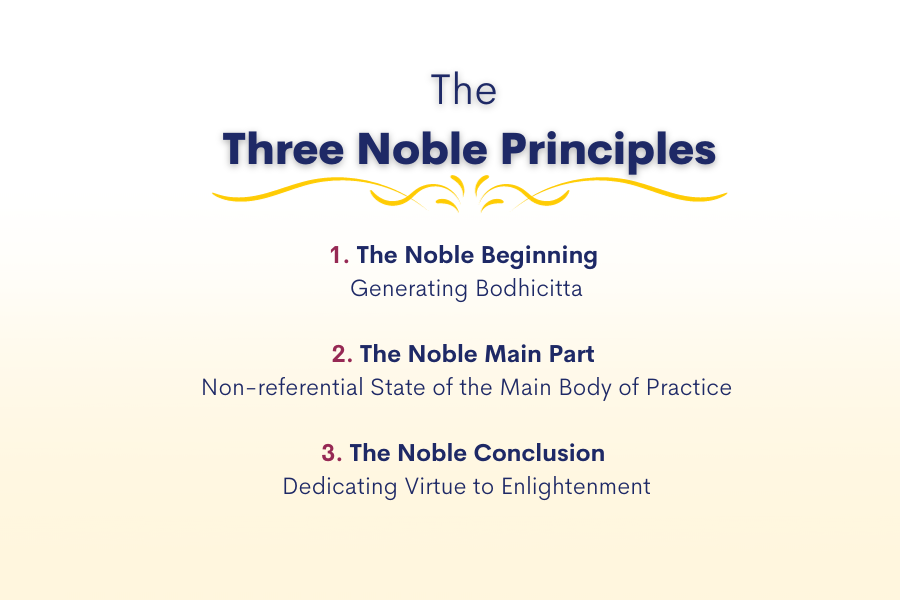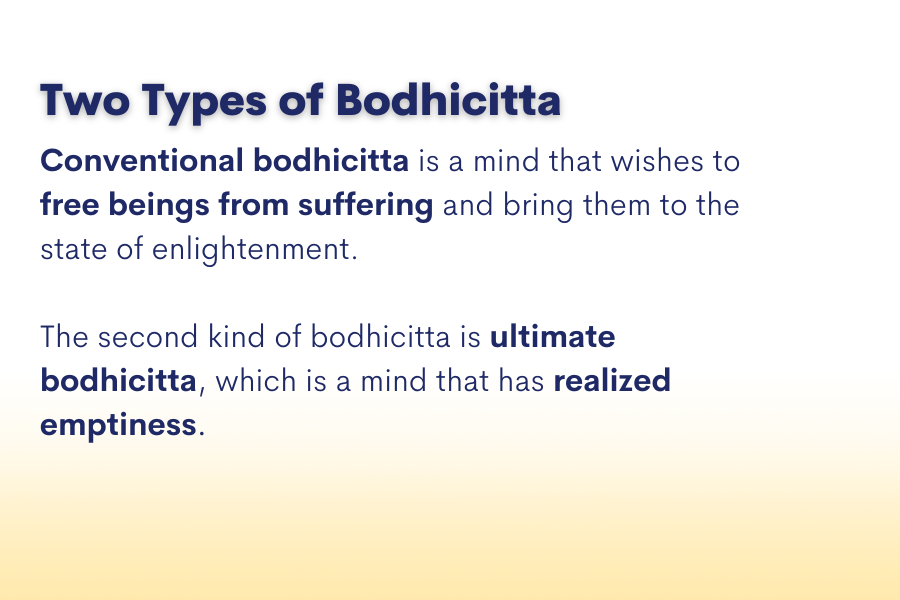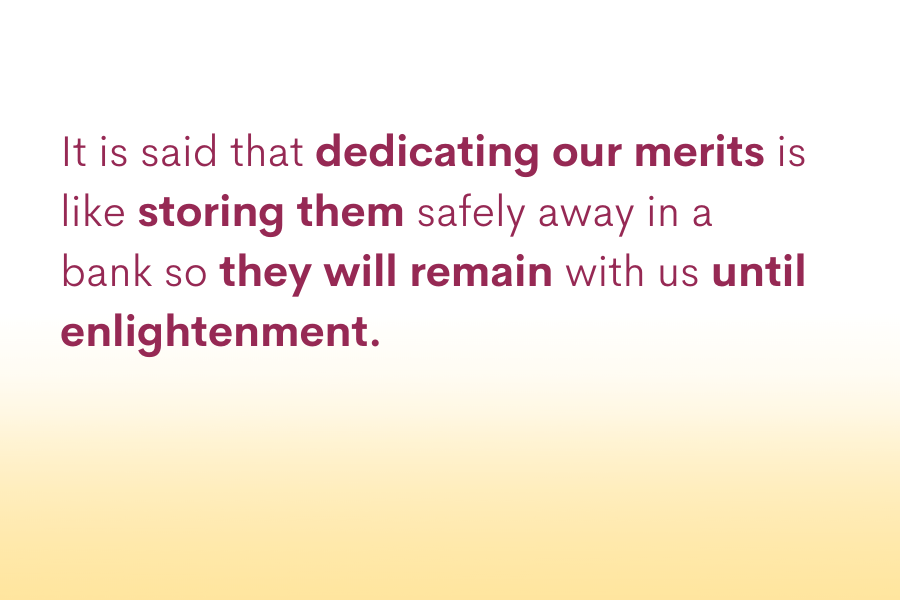The Three Noble Principles are:
- The Noble Beginning: Generating Bodhicitta
- The Noble Main Part: Non-referential State of the Main Body of Practice. Don’t worry, we will describe what that means soon
- The Noble Conclusion: Dedicating Virtue to Enlightenment

The Noble Beginning: Generating Bodhicitta
First, why do we begin our practice sessions with bodhicitta? As some of you have heard, “If you don’t have a target in mind, you’re unlikely to hit it.” So, if you don’t have a strong, clear purpose in mind for this practice right now, you will wander through it, come to the end, and have very little to show. On the other hand, if you do have a strong, clear purpose at the top of your mind as you go into the practice, it will empower your practice considerably and in just the direction that you’re aiming for.

The primary aim in all Buddhist traditions is liberation from suffering, freedom from the cycle of this bad dream we call samsara. Bodhicitta is the wish for such freedom not only for ourselves but for all beings. If we begin our practice with this purpose in mind, no matter how small an act of generosity or brief a session of meditation we may engage in, it will serve as a cause for the freedom and enlightenment of ourselves and all beings.
There are two kinds of bodhicitta: conventional and ultimate. Conventional bodhicitta is a mind that wishes to free beings from suffering and bring them to the state of enlightenment. The second kind of bodhicitta is ultimate bodhicitta, which is a mind that has realized emptiness.
When our vision is obscured, we see ourselves as only waves and forget that the ocean gives rise to us and everything in creation. think of it as a quality of the ocean. Bodhicitta can be felt on the ocean and the wave levels–Conventional bodhicitta focuses more on the “waves” part, while ultimate bodhicitta is the ocean.
Within conventional bodhicitta, there are two aspects: aspirational and engaged, so naturally, we have trainings for each aspect. To develop aspirational bodhicitta, we first cultivate the wish to liberate beings from suffering and bring them to enlightenment. It’s not necessarily engaging in any action towards the wish but developing the wish itself. The second side is engaged bodhicitta, which turns aspirations into actions toward liberation. To break it down: If we want to go to a place, that’s our aspiration, and taking the steps to get there is our engagement.
Within the first of these Three Noble Principles, we are referring to generating conventional, aspirational bodhicitta. That is, whatever practice we engage in, we are doing it to free all beings from suffering and bring them to the state of enlightenment.
The Noble Main Part: the Non-referential State of the Main Body of Practice
Most likely, this is not a phrase most of us use daily. This means that in whatever practice we engage in, whether it be a shamata meditation, listening to a dharma teaching, or a mantra recitation, we do not fall into ordinary thinking.
This can be discussed on a few levels. On the highest level, a practitioner would be seeing the ultimate nature of all things through the practices of Dzogchen, Mahamudra, or the Great Middle Way and, in that way, not falling into ordinary thinking. On a more fundamental level, which may be more applicable, it means remaining single-pointedly focused on whatever practice we are doing and not falling into distraction.
The Noble Conclusion: Dedicating Virtue to Enlightenment
This brings us back to our original purpose for doing the practice, as we now act to bring it to a close. Dedication is to give away all the virtues of our practice as a gift for all sentient beings with the wish that these virtues may serve as a cause for their freedom and enlightenment. It is said that dedicating our merits is like storing them safely away in a bank so they will remain with us until enlightenment. The Buddha stated in the Sutra requested by Sagara Mati, “Just as a drop of water that falls into the great ocean isn’t exhausted until the ocean is exhausted, virtues thoroughly dedicated to enlightenment will not be exhausted until the attainment of enlightenment.”
It’s also a powerful reminder that our purpose is more than achieving worldly success or temporary happiness.

With them, even more simple acts and practices become profound causes of enlightenment. Without them, even the most profound practice becomes weak and ineffective in achieving our ultimate goal.
As we apply these principles to our meditation practice, interactions, and work, we move toward liberation while helping those around us do the same. We are grateful to share the lofty goal of enlightenment and the journey to reach it with you.
**Longchen Rabjam Drimé Özer was a Tibetan Buddhist adept in the Nyingma tradition. He is famous for clarifying the Dzogchen methods within Vajrayana Buddhism in his Seven Precious Treasuries, three texts on resting and their auto-commentaries, and more.
Read more about him here: https://treasuryoflives.org/biographies/view/Longchenpa-Drime-Wozer/2882
